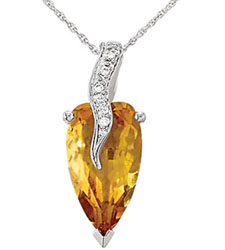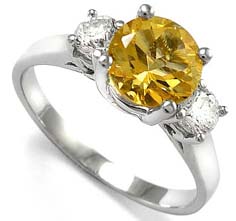Shining with a golden glow, people have long treasured citrine as a gift from the sun. Citrine, a variety of transparent quartz, is named after the French citron, or lemon. Its color ranges from a juicy lemon yellow to a bright orangey brown. In all of its glorious golden and yellow colors, citrine is the most affordable of all the earth-toned gemstones, the perfect complement to all the warm tones in your wardrobe. Its sunny shades are also a lovely way to light up black and gray or contrast against blue.
Citrine was particularly popular in the retro jewelry of the 1940s. Its sunny color and dramatic proportions suited the streamlined style and bold gold of the era. It was often set with ruby, peridot, and aquamarine in colorful brooches, necklaces and bracelets. Jewelry designers today also love to set citrine in yellow gold, either alone or in combination with amethyst, blue topaz, or peridot.
The prices, uses and value of citrine quartz vary tremendously, depending on the size and quality of the gemstone.
Why Buy Loose Gemstones Instead of Pre-Set Jewelry?
There are many reasons, but basically it boils down to value and choice...
When buying your gemstone loose instead of a pre-set stone, you can be sure you are getting the best value for your money. Unset gemstones are less expensive, a better value, and you can really see what you are paying for. The most important part of getting the right price and finding the best value is to first see what you're getting. A jewelry setting will hide the inclusions inside a gem, and can deepen or brighten its color. With a loose stone you can much more easily inspect the gem and see it for what it really is. In this way you can get a better idea of its true worth and be sure you are paying a fair price.
The second advantage of buying a loose gemstone is choice. You are free to pick the exact color, cut, shape and variety of the stone for the setting of your dreams, be it yellow gold, white gold, platinum or silver; prong set or bezel set with diamond accents. You can experience the joy of creating your very own, one-of-a-kind jewelry design. Choose from a variety of jewelry settings and styles to create a completely original presentation that will perfectly suit your individual gemstone and will be as unique as you are!


| Origin | The most important deposits of natural citrine are in Brazil. Other locations include Argentina, Madagascar, Myanmar (Burma), Namibia, Russia, France, Scotland and Spain. |
|---|---|
| Color | Light to dark yellow, lemon yellow, golden, orange, gold-brown, Madeira |
| Refractive Index | 1.544 - 1.553 |
| Chemical Composition | SiO2 |
| Hardness | 7 |
| Density | 2.6 - 2.7 |
| Crystal Structure | Hexagonal |
Citrine is a macrocrystalline variety of the mineral Quartz (SiO2). Quartz is one of the most abundant minerals on earth. It makes up about 12% of the earth's crust, occurring in a wide variety of igneous, metamorphic and sedimentary rocks.
Quartz varieties are commonly separated into two groups based on the size of the individual grains or crystals; macrocrystalline quartz in which individual crystals are distinguishable with the naked eye, and cryptocrystalline quartz in which the individual crystals are too small to be easily distinguishable under the light microscope.
Some of the macrocrystalline quartz varieties are: Amethyst, Ametrine, Cat's-eye Quartz, Citrine, Phantom Quartz , Rock Crystal, Rose Quartz, Rutilated Quartz and Smoky Quartz. Blue Aventurine Quartz and Green Aventurine Quartz are actually quartzites (a rock, not a mineral) composed essentially of interlocking macrocrystalline quartz grains with disseminated grains of other color imparting minerals.
The cryptocrystalline varieties of quartz may be separated into two types; fibrous and microgranular. Chalcedony is the general term applied to the fibrous cryptocrystalline varieties. Agate is an example of a fibrous cryptocystalline banded chalcedony variety of quartz. Carnelian, Chrysoprase and bloodstone are other chalcedony varieties. Chert is the general term applied to the granular cryptocrystalline varieties of quartz, of which flint and Jasper are examples.
Naturally occurring citrine derives its golden color from the presence of iron (Fe3) ions. The difference between amethyst and citrine is only the oxidation state of the iron impurities present in the quartz. Upon heating, the iron impurities are reduced and amethyst's purple color fades and becomes yellow to reddish-orange (citrine), green, or colorless depending on the site and original oxidation state of the iron impurities present and the amount and duration of the heating. The amethystine color usually can be regained by irradiation which re-oxidizes the iron impurities. This irradiation can be done by synthetic means, or it can occur in nature by radioactive decay of nearby radioactive minerals. In most cases this is a reversible process, however excessive heating may change the distribution of the iron impurities at the different sites within the quartz making it impossible to convert it back to amethyst by subsequent irradiation. The heating process can occur naturally or synthetically.
Citrine has a chemical formula of SiO2, a density of 2.60 - 2.70, and a refractive index of 1.544 - 1.553. The refractive index (RI), measured using a refractometer, is an indication of the amount light rays are bent by a mineral. Birefringence is the difference between the minimum and maximum RI. When birefringence is high, light rays reflect off different parts of the back of a stone causing an apparent doubling of the back facets when viewed through the front facet.
Most loose citrine is mined in Brazil, particularly the state of Rio Grande do Sul. Natural citrine can also be found in the Ural Mountains of Russia, in Dauphine, France, and in Madagascar. Historically, it has been found in Spain, on the Scottish island of Arran, in Hungary and in several mines overseas.
Citrine has been used in Greece since the Hellenistic period at the end of the 4th to the end of the 1st century BC.
It has been said that Citrine helps to manifest your goals.
Citrine is a cheerful gem. Its powers are said to include making its wearer lighthearted, bringing cheerfulness in tough times and offering hope.
It was also believed to help relax people and expel impurities from the body. People who wore citrine could expect to look healthy and feel happy.
Citrine does not absorb negative energies but rather dissipates and transmutes them, which is why this stone is good for clearing your aura.
Citrine relieves itching and soothes allergic reactions. It also enhances abundance and aids the ability to organize.
It attracts abundance, prosperity, and success, and because of this Citrine has been nicknamed the "success stone."
Citrine stimulates the solar plexas and third eye chakras, promoting stamina and activating intuition.
It can also help to overcome sleep related problems such as insomnia and nightmares.
Physically it is said to help with poor blood circulation, digestion, allergies, and an aid to curing life-threatening diseases.
In ancient times, citrine was carried as a protection against snake venom and evil thoughts.
Citrine is the birthstone for the month of November and the gemstone representing the 13th wedding anniversary.

